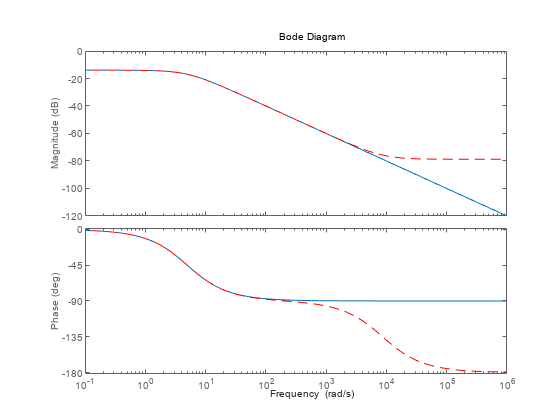balreal
Balanced state-space realization
Description
[
computes a balanced state-space realization of the LTI model sysb,g] = balreal(sys)sys. For
stable models, sys is an equivalent realization for which the
controllability and observability Gramians are equal and diagonal, their diagonal entries
forming the vector g of Hankel singular values. This balances the
input-to-state and state-to-output energy transfers, and small entries of
g indicate states that you can remove with xelim.
If sys has unstable poles, the function isolates the stable part,
balances it, and adds back to the unstable part to form sysb. The
entries of g corresponding to unstable modes are set to
Inf.
[
computes the balanced realization using options specified as one or more name-value
arguments. (since R2023b)sysb,g] = balreal(sys,Name=Value)
Examples
Input Arguments
Name-Value Arguments
Output Arguments
Tips
For model order reduction purposes, use reducespec.
Algorithms
Consider the stable state-space model
with controllability and observability Gramians Wc and Wo.
The state coordinate transformation produces the equivalent model
balreal transforms the Gramians to
such that
If the model has unstable poles, the function isolates the stable part, balances it, and
adds back to the unstable part to form the realization. The entries of g
corresponding to unstable modes are set to Inf.
See [1] and [2] for details on the algorithm.
If you use the TimeIntervals or FreqIntervals
options, then balreal bases the balanced realization on time-limited or
frequency-limited controllability and observability Gramians. For information about
calculating time-limited and frequency-limited Gramians, see gram and [4].
References
[1] Laub, A., M. Heath, C. Paige, and R. Ward. “Computation of System Balancing Transformations and Other Applications of Simultaneous Diagonalization Algorithms.” IEEE Transactions on Automatic Control 32, no. 2 (February 1987): 115–22. https://doi.org/10.1109/TAC.1987.1104549.
[2] Moore, B. “Principal Component Analysis in Linear Systems: Controllability, Observability, and Model Reduction.” IEEE Transactions on Automatic Control 26, no. 1 (February 1981): 17–32. https://doi.org/10.1109/TAC.1981.1102568.
[3] Laub, Alan J. “Computation of ‘Balancing’ Transformations.” Joint Automatic Control Conference, no. 17 (1980): 84. https://doi.org/10.1109/JACC.1980.4232165.
[4] Gawronski, Wodek, and Jer-Nan Juang. “Model Reduction in Limited Time and Frequency Intervals.” International Journal of Systems Science 21, no. 2 (February 1990): 349–76. https://doi.org/10.1080/00207729008910366.
Version History
Introduced before R2006aSee Also
reducespec | gram | xelim | ssequiv
